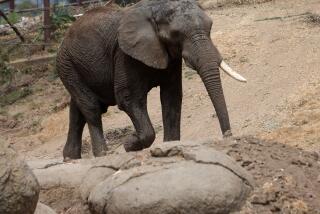Elk
- Share via
[CERVUS ELAPHUS]
What’s that eerie sound? The squealing, quavering, whistling bellow of elk reverberates this month and next throughout the northern woods of Del Norte and Humboldt counties, where it’s rutting time. Once plentiful in California, elk rebounded from near extinction after being overhunted in the late 1800s. Several thousand now roam the coastal mix
of old-growth forest, grassy meadow
and open clear cut.
Besides bugling, males weighing as much as 1,000 pounds may roll in pungent, urine-soaked mud as a way to advertise their presence to other males . Wildlife enthusiasts who make the pilgrimage to Redwood National and State Parks love the show but know to keep their distance. Even nearby harems of females and calves scatter when the edgy males’ superhormone-charged standoffs escalate into wild chases or potentially deadly battles. The payoff for all this drama? Adorable, gangly calves born in early summer.
NATURAL HISTORY
Mainly found in open meadows near forested
or brushy habitats, often near water. Usually stick
to herds, though large males may live alone except
to mate. Graze on a variety of tasty vegetation
such as blackberry shoots, vine maples,
salmonberry and huckleberry.
KEY CHARACTERISTICS
Golden-brown, standing nearly 5 feet tall
at the shoulder. Adult males distinguished by spreading racks of antlers, up to 5 feet wide,
and shaggy, dark brown manes.
More to Read
Sign up for Essential California
The most important California stories and recommendations in your inbox every morning.
You may occasionally receive promotional content from the Los Angeles Times.










